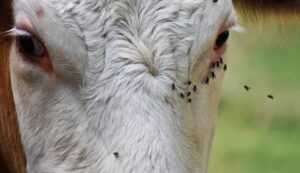Healthy Cattle, Happy Farmer: The Role of Fly Control
go.ncsu.edu/readext?932325
en Español / em Português
El inglés es el idioma de control de esta página. En la medida en que haya algún conflicto entre la traducción al inglés y la traducción, el inglés prevalece.
Al hacer clic en el enlace de traducción se activa un servicio de traducción gratuito para convertir la página al español. Al igual que con cualquier traducción por Internet, la conversión no es sensible al contexto y puede que no traduzca el texto en su significado original. NC State Extension no garantiza la exactitud del texto traducido. Por favor, tenga en cuenta que algunas aplicaciones y/o servicios pueden no funcionar como se espera cuando se traducen.
Português
Inglês é o idioma de controle desta página. Na medida que haja algum conflito entre o texto original em Inglês e a tradução, o Inglês prevalece.
Ao clicar no link de tradução, um serviço gratuito de tradução será ativado para converter a página para o Português. Como em qualquer tradução pela internet, a conversão não é sensivel ao contexto e pode não ocorrer a tradução para o significado orginal. O serviço de Extensão da Carolina do Norte (NC State Extension) não garante a exatidão do texto traduzido. Por favor, observe que algumas funções ou serviços podem não funcionar como esperado após a tradução.
English
English is the controlling language of this page. To the extent there is any conflict between the English text and the translation, English controls.
Clicking on the translation link activates a free translation service to convert the page to Spanish. As with any Internet translation, the conversion is not context-sensitive and may not translate the text to its original meaning. NC State Extension does not guarantee the accuracy of the translated text. Please note that some applications and/or services may not function as expected when translated.
Collapse ▲ It is that time of year when everything is starting to warm up and flies are starting to come out. Flies not only aggravate you and your cattle, but they can also pose a threat by introducing pinkeye to your cattle herd. There are some ways to help prevent pinkeye and now is the right time to start treating flies on your cattle.
It is that time of year when everything is starting to warm up and flies are starting to come out. Flies not only aggravate you and your cattle, but they can also pose a threat by introducing pinkeye to your cattle herd. There are some ways to help prevent pinkeye and now is the right time to start treating flies on your cattle.
Have you tried spraying your cattle for flies and they just keep coming back? What about using pour-on insecticide? Well if you have used those in the past and it seems to not be touching your cattle this time, let me help give you some tips and tricks to help your fly problem.
Are you using fly tags? If so, great! If not, then why not? I understand the cost of the tags is not cheap, but it is cheaper than treating pinkeye. Pinkeye is spread from cow to cow with an infected fly that gathers at its eyes. Pink Eye can lead to blindness and in some cases the total loss of the eye. There are some vaccines on the market to help prevent pinkeye. Unfortunately, it is like the flu. There are different variants of it that go around, and it changes every year. That’s why it is a good idea to use fly tags on cattle. They work great when paired with a pour-on insecticide. The two paired together will help you get the best coverage against flies. It is important to rotate the types of tags and insecticides that you use every year on your cattle.
If you find yourself using the same pour-on and fly spray and you are not seeing the results you would like to see, the chances are very high that the flies have built-up immunity to it over the generations. So, if you do use fly tags it is important to rotate what types you use every year, this will help to lower the flies’ chance of building immunity. It is just like rotating your cattle dewormers so the worms do not build immunity to them.
While some companies make cattle licks with ‘fly deterrent’ in them it is important to read the label closely. Some products do not work properly unless the correct amount is consumed per animal. Most products that contain ‘fly deterrents’ only work when a certain amount is eaten per cow. Something else to be careful about is most of them only prevent fly larvae from hatching from the cow’s manure. Therefore, it is not going to help prevent flies from coming from neighboring farms.




